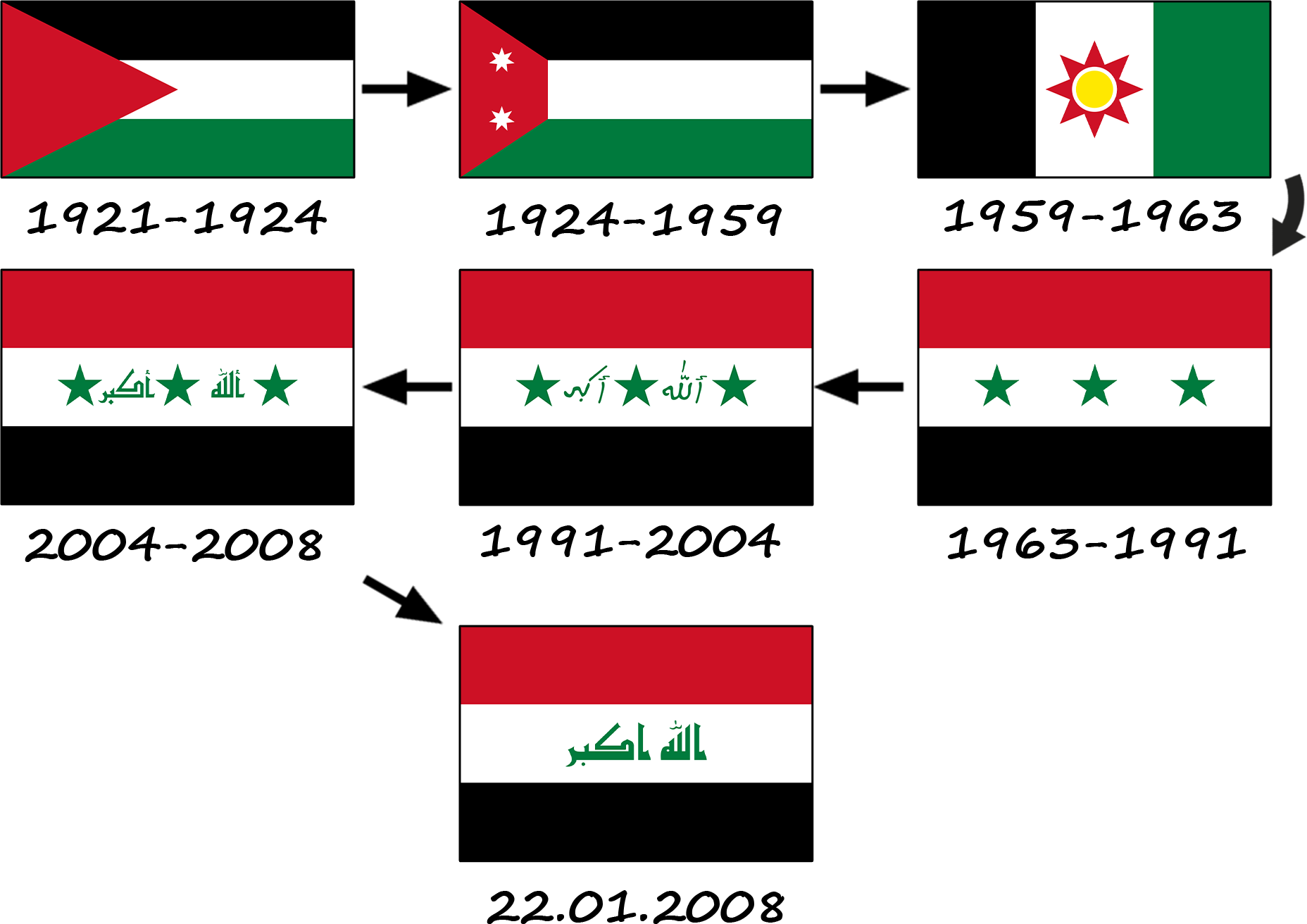The Iraqi flag consists of three horizontal colors arranged in order from top to bottom: red, white, and black. In the middle of the white stripe, the phrase "Allāhu Akbar" is written in green.
The Iraqi flag consists of three horizontal colors arranged in order from top to bottom: red, white, and black. In the middle of the white stripe, the phrase "Allāhu Akbar" is written in green.
All colors of the flag have their own meaning, namely:
The phrase "Allāhu Akbar" was added by Saddam Hussein to indicate that the state of Iraq belongs to the Islamic religion and is committed to it.
The colors of the Iraqi flag come from a poem by poet Safi al-Din Khali: "Our crafts are white, our facts are black, our pastures are green, our pastures are red."

After the First World War, Britain occupied Iraq and handed over power to the son of the then ruler, Hussein bin Ali (King Hijaz), who used his father's flag in 1921. The flag consisted of horizontal stripes of black, white, and green with a red triangle on the left. This flag design was used until 1924.
From 1924 to 1959, the flag design was changed - the triangle was cut to form a trapezoid, on which two white seven-pointed stars were placed, symbolizing the 14 governorates of the Kingdom.
A completely new flag was created on July 14, 1959, after the overthrow of the Iraqi monarchy in 1958. The flag has vertical stripes in the order of black, white and green, with an eight-rayed red sun and a yellow circle in the center.
The colors of the flag symbolize the following:
The red eight-pointed star and yellow circle represent Arabs and Kurds. The symbolism of the star was interpreted as a symbol of freedom, which caused controversy at the time, as some communist parties adopted this sun and red color.
On July 31, 1963, the countries of Egypt, Syria, and Iraq attempted to form a new union and adopt a version of the Arab Liberation Flag as the new flag to replace the 1959-1963 flag, with some changes, placing three stars on it to represent the three countries of the union. Although the attempt failed, Iraq added three green stars to the flag to express its desire to reunite with the countries. The flag also contains horizontal lines of red, white, and black, where red stands for the desire for bloodshed and black for battles and wars. The green color symbolizes the prosperity of the Arab fields, and the white color symbolizes the purity of motives and actions.
The Iraqi flag was modified by adding a handwritten phrase (Allahu Akbar). The modification was approved on January 14, 1991, after Iraq's invasion of Kuwait. The three-star symbol was officially changed to represent the Baath Party's goals of "unity, freedom and socialism." As for the addition of the phrase "Allahu Akbar" between the stars, it was added, perhaps as an attempt to gain the support of the Islamic world before the Second Gulf War. Indeed, this phrase was written in the handwriting of former President Saddam Hussein, and this flag existed until it was changed in 2004. This flag was displayed in front of the United Nations building and at the 1992 Olympic Games in Barcelona.
After the overthrow of the regime, on April 26, 2004, the Iraqi Government Council announced a new national flag. The proposed flag looked like this: a white background with parallel lines of blue, yellow and blue in the lower quarter of the flag. The rest of the white space was occupied by a large blue Islamic crescent. The two blue lines represent the Tigris and Euphrates rivers, and the yellow line symbolizes the Kurdish component in Iraq (as Kurdish leaders demanded that the unified Iraqi flag should have a symbol representing the Kurdish minority). The addition of blue to the white on the flag caused much controversy in Iraq, in addition to the absence of the usual colors for Arab flags, as well as the removal of the phrase "Allahu Akbar". However, the rejection of the flag by the Iraqi people led to the cancellation of the project, which was accused of deliberately distancing Iraq from its Arab surroundings, in addition to the fact that the proposed flag bore a resemblance to the flag of Israel. As a result, the old version of the 1991-2004 flag remained, but with one exception. The phrase "Allahu Akbar", written in Saddam Hussein's handwriting, was rewritten in Kufic script (a decorative font of Iraqi origin used in the Quran).
On January 22, 2008, the Iraqi Council of Representatives approved a law to change the flag, according to which the three stars (which previously symbolized the unity that failed between Egypt, Syria and Iraq in 1963) were removed, while the Kufic spelling of the phrase "Allahu Akbar" was preserved. The new Iraqi flag was officially raised over the Prime Minister's office in Baghdad on Tuesday, February 5, 2008.